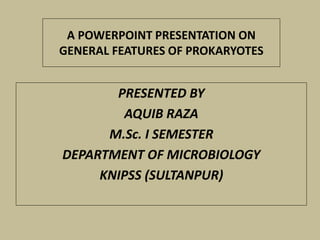
GENERAL FEATURES OF PROKARYOTES
- 1. A POWERPOINT PRESENTATION ON GENERAL FEATURES OF PROKARYOTES PRESENTED BY AQUIB RAZA M.Sc. I SEMESTER DEPARTMENT OF MICROBIOLOGY KNIPSS (SULTANPUR)
- 2. INTRODUCTION •All living organisms on earth are composed of one or the other of two types of cells; prokaryotic cells and eukaryotic cells based on differences in cellular organization and biochemistry. •Prokaryotic cells (pro or primitive) do not have a membrane- bound nucleus. Prokaryotes includes Bacteria and Archaea. All bacteria and blue green algae are prokaryotes. •Most prokaryotes are small, single-celled organisms that have a relatively simple structure.
- 3. GENERAL FEATURES • They lack nuclear membrane. • Mitochondria, golgi bodies, chloroplast and lysosomes are absent. • The genetic material is present on a single chromosome. • The cell wall is made up of carbohydrates and amino acids. • They divide asexually by binary fission. • The sexual mode of reproduction involves conjugation.
- 5. SHAPE • Depending on their shape, bacteria are classified into several varieties: • Cocci: Cocci (s., coccus) are spherical, Eg., Streptococci etc. • Bacilli: Bacilli (from baculus meaning rod) are related straight, rod shaped. Eg., Mycobacterium tuberculosis etc. • Spirilla: They are rigid, spiral shaped cells that usually tufts of flagella at one or both ends. Example: Helicobacter pylori etc. • Spirochetes: They are flexible, spiral-shaped bacteria that have a unique, internal flagellar arrangement. Eg., Treponema pallidium etc. • Vibrios: They are curved or comma-shaped rods and derive from their characteristic motility. Eg., Vibrio cholerae etc.
- 7. PROKARYOTIC CELL ORGANIZATION • Plasma membrane • Cell wall • Inclusion bodies • Gas vacuole • Ribosomes • Nucleoid • Plasmids • Capsules and slime layers • Fimbriae and pili • Flagella
- 8. PLASMA MEMBRANE • Every prokaryote has a cell membrane, also known as the plasma membrane. It is a double layer of lipid, (Phospholipid) that separates the cell from the outside environment. • Functions: • Retaining the cytoplasm. • Control permeability. • Transport electrons and protons for cellular metabolism. • Contain enzymes to synthesise and transport cell wall substance.
- 9. FLUID MOSAIC MODEL OF PLASMA MEMBRANE
- 10. • The cell wall of prokaryotes is composed of peptidoglycan. • Functions : • Maintain the cell’s shape. • Protect the cell interior. • Prevent the cell from bursting when cell takes up water. CELL WALL
- 11. GRAM POSITIVE AND GRAM NEGATIVE CELL WALL • Gram-positive bacteria lack an outer membrane but are surrounded by layers of peptidoglycan many times thicker than is found in the Gram-negatives. Eg., Mycobacterium tuberculosis • Gram-negative bacteria are surrounded by a thin peptidoglycan cell wall, which itself is surrounded by an outer membrane containing lipopolysaccharide. Eg., E.coli
- 12. GRAM POSITIVE AND GRAM NEGATIVE CELL WALL
- 13. CAPSULE • Many prokaryotes have a sticky outermost layer called the capsule, which is usually made of polysaccharides. • The capsule helps pathogenic bacteria to resist phagocytosis . Eg., Streptococcus pneumoniae. • They prevent the cell from drying out. • They aid in attachment to solid surfaces.
- 14. PROKARYOTIC CYTOSKELETONS INCLUSION BODIES AND GAS VACUOLE 1. Inclusion bodies are non-living granules of organic and inorganic materials. These bodies are used for storage. 2. Gas vacuole, a structure that provides buoyancy to some aquatic prokaryotes. • Gas vacuoles, are present in many photosynthetic bacteria and a few other aquatic prokaryotes such as halobacterium (a salt loving archaeon).
- 15. INCLUSION BODY AND GAS VACUOLE
- 16. RIBOSOMES • Ribosomes are very complex structures made of both protein and ribonucleic acid (RNA). They are the site of protein synthesis. • Bacterial and archaeal ribosomes are called 70S ribosome and are constructed of a 50S and a 30S subunit.
- 17. PROKARYOTIC RIBOSOME (30S SUBUUNIT AND 50S SUBUNIT)
- 18. NUCLEOID AND PLASMIDS • The nucleoid is an irregularly shaped region that contains the cell’s chromosome and numerous proteins. • Nucleoid is also known as nuclear region, the nuclear body, and chromatin body. • Plasmids are small, double-stranded DNA molecules that can exist independently of the chromosome. Both circular and linear plasmids have been documented, but most known plasmids are circular.
- 20. EXTERNAL STRUCTURES FIMBRIAE AND FLAGELLA • Many bacteria and archaea have structures that extend beyond the cell envelope. These structure can function in protection, attachment to the surfaces, etc. • FIMBRIAE- Many bacteria and archaea have short, fine, harelike appendages known as Fimbriae. • FLAGELLA- They are hairlike structure that acts primarily as an organelle of locomotion in the cells of many living organisms. Most motile prokaryotes move by use of flagella.
- 22. 𝓣𝓱𝓪𝓷𝓴 𝔂𝓸𝓾